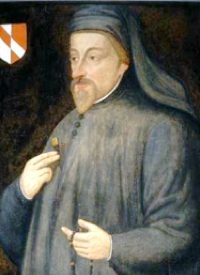
This October 25 marks the 609th anniversary of the death of Geoffrey Chaucer, one of the most famous writers in the history of English literature and author of the renowned work, The Canterbury Tales.
Chaucer’s name has survived more than six centuries because he was a writer of truly great literature. Short of hard experience, great literature is the best way to learn about life, and it is a much gentler teacher — if the student will learn. It gives readers a "test run" through life’s maze before they have to face challenges themselves. It provides a wholesome outlet to man’s innate desire for entertainment, for which he learns to ask from his earliest days in the childhood plea, "Tell me a story!" And the truths great literature embodies provide something to cling to, especially these days as the world goes mad.
A good way to place Chaucer in history is to think that Dante published The Divine Comedy in 1300, Chaucer died in 1400, and Shakespeare produced Hamlet in 1600. Geoffrey Chaucer’s exact date of birth is unknown, but 1343 is the generally accepted year. Other details of his life are more certain. We know that he was from a prominent merchant family. Early in his career he served the wife of Prince Lionel, son of King Edward III, and it was during that time he met John of Gaunt, another son of Edward III and father of the future King Henry IV.
Chaucer went on to serve as a soldier during England’s invasion of France in 1359. He was captured there and ransomed in 1360 after several months of imprisonment, during which he was able to study some French literature. In 1366 he married John of Gaunt’s sister-in-law, Phillipa, and they had four children. By 1367, Chaucer had already established himself as a writer and as a result was given a royal pension. In that same year, he was appointed as a diplomat to Italy where he immersed himself in Italian literature, focusing on Dante, Boccaccio, and Petrarch. This training, combined with knowledge gleaned from his time in France, allowed him to translate some of the greatest French and Italian works into English.
He led an honorable and colorful career through the next three decades, and all the time he continued writing. In 1374 the crown appointed him Controller of Customs for woolskin and hide, and in 1382, he advanced to the enviable position of Controller of Customs for the wine trade. In 1386, he became a member of Parliament. King Richard II made him Clerk of the King’s Works in 1389, a fancy title meaning that he was overseer of all bridges and parks in the kingdom. The year 1391 saw him promoted to Royal Forester in Somerset, an even more prestigious position than any he had yet held. The life pension the king granted him in 1394 was increased the next year by King Henry IV, son of Chaucer’s old friend, John of Gaunt. Chaucer spent the last years of his life at court, supported and honored by the king.
Probably due to the pensions he received, Chaucer wrote the bulk of his original works later in life. His most lasting accomplishment is The Canterbury Tales. Literature historians agree he probably began writing it in the 1390s. Written in Middle English, the story opens with 29 pilgrims setting out on a journey to Canterbury Cathedral to pay homage at the shrine of St. Thomas á Beckett. The group’s host, Harry Bailly of the Tabard Inn, enjoins on them a friendly wager. Each pilgrim is to tell four stories, two on the way to Canterbury and two on the return trip. Back at the inn, all the pilgrims would vote as to who told the best story, and the winner would get free dinner at the Tabard. Regrettably, Chaucer never lived to finish The Canterbury Tales, but the 24 stories he did complete still delight readers after 600 years. His book teaches us more about day-to-day life in Medieval England than any other. Perhaps its most important contribution, however, is the moral that our journey through life has a destination that is not in this world, and we only have a short time to prepare to reach it.
Geoffrey Chaucer is buried in Westminster Abbey, the first poet to ever have that honor. His tomb is located in the area now known as Poet’s Corner which includes the graves of 29 other artists including Alfred Lord Tennyson, Charles Dickens and George Frederic Handel, and memorials to several dozen others. The inscription on Chaucer’s grave reads, in part, "Of old the bard who struck the noblest strains, Great Geoffrey Chaucer, now this tomb retains." Requiem aeternam dona ei, Domine: et lux perpetua luceat ei.
Source: White, David Allen, Ph.D., Chaucer’s The Canterbury Tales. Winona Lecture Seminar. St. Thomas Aquinas Seminary, Winona, Minnesota, 15 July 2002.




